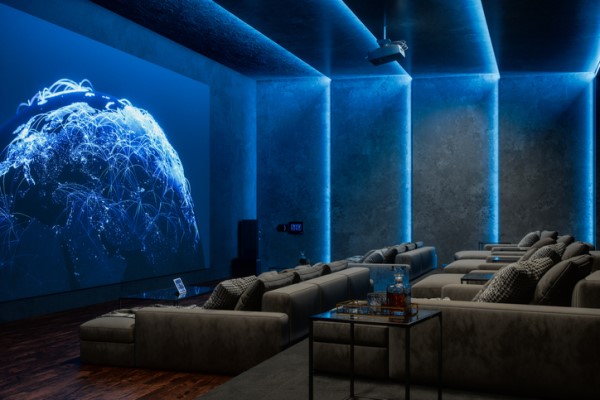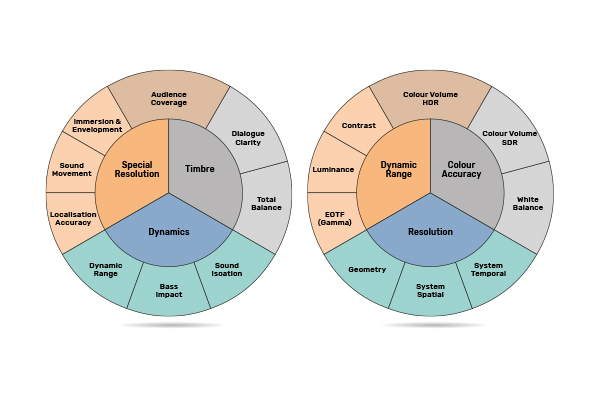Lifting the lid on RP23 for video design
CEDIA has released its latest recommended practice, this one on video design. David Meyer explores the topic and explains what integrators need to know.
Think back to a cinema experience where you were completely drawn in. You practically forgot where you were, immersed in the narrative as reproduced with big picture and sound with visceral and emotional responses.
ADVERTISEMENT
Having such an experience is what the content creators hope for — the faithful reproduction of their artistic intent. It’s what some in the industry refer to as the “suspension of disbelief”. And it’s what the CEDIA/CTA recommended practices for immersive AV aim to help integrators deliver to their clients.
Back in August 2023 the CEDIA/CTA-RP22 Immersive Audio Design Recommended Practice, RP22 for short, was released. It recommends design objectives and parameters for immersive audio systems ranging from a modest 3.1.2 system in a living space, right up to 30-plus channels for the highest spatial resolution DCI private cinema.
RP22 was very well received by the broader industry and quickly became the most downloaded digital publication CEDIA has ever released, and by a big margin too — we’re talking thousands of copies. Since then, many keen integrators have attended RP22 Workshops to immerse themselves in the design technicalities (yeah, pun intended).
What a lot of people may not realise is that the hefty document was created by a working group of volunteers conducting hour-long Zoom calls (with occasional offline homework) every week for over three years (!). Contributors included experts from award-winning integrators, specialist manufacturers, and immersive audio stakeholders including folks from Dolby, Xperi (DTS) and even Skywalker Sound.
I find myself wondering what the total monetary value of contributions would have been, had we quantified it on hourly rates. That is, if you could even put a price on it. But the document remains completely free of charge for anyone, not just CEDIA and CTA members. So, if you work with immersive audio systems and don’t already have RP22, consider this a friendly nudge.
Next, video takes the stage.
In what is set to be called CEDIA/CTA-RP23 Immersive Video Design Recommended Practice, this upcoming document will serve as a close companion to RP22, being crafted by a different volunteer working group of video experts.
During the development of RP22, there was plenty of debate about whether video or audio parameters should primarily determine the reference seating position (RSP). Some argue that the RSP should be based on screen size and distance, then build the audio around it. Others insist that audio should be primary to optimise spatiality and avoid room modes. In practice, both are right. Optimal RSP location should factor both audio and video parameters, juggling the two to settle on the best spot. That’s why RP23 will be so important for use in tandem with RP22.
To ensure consistency and familiarity, RP23 will be built with the same general format and attributes of performance objectives, performance parameters and performance levels. Level 1 is regarded as the minimum necessary to convey basic artistic intent, through to Level 4 which represents the maximum performance across every parameter, with Levels 2 and 3 as progressive tiers in-between.
Performance objectives
A great thing about video is that it’s entirely objective. If a pixel of content is supposed to be reproduced as a particular shade of green, it’s measurable as such. Same goes for black level and brightness (together defining contrast/dynamic range). Resolution is even simpler. Video is very predictable.
By comparison, audio is so complex and variable. A high-spec system can sound ordinary in a bad room, not even achieving Level 1. Conversely, a modest system set up really well in a great, acoustically optimised room can sound fantastic. That’s in the hands of the designer.
Pictured are two performance objective wheels. The left one is for audio, straight out of RP22, Section 3. At its centre are three core characteristics surrounded by numerous grouped performance objectives. The wheel on the right is for video. It’s important to note that this is concept only that I devised for pictorial purposes. I basically just reassigned each of the wedges to video parameters for direct comparison. It may that this diagram, or an approximation or even expansion of it will probably make its way into RP23. Don’t know yet.
As you can see, the three main video characteristics are:
- Dynamic range: I think this will definitely prove to be the most challenging for designers, especially with projection systems.
- Colour accuracy: An essential and perhaps assumed ingredient in video. But don’t assume that colours are always accurate. A good display will be able to support a great range of colours; a better one will enable fine calibration to ensure accuracy.
- Resolution: This one is relatively simple. If you want 4K, then be sure the display is native 4K. But resolution is also reliant on the geometry setup and the presence of a high integrity, native resolution video signal free of artifacts.
Performance parameters
As I write this, RP23 still exists as a working spreadsheet of parameters, not yet being formed into a document. But there are lots of parameters, many of which are due to the distinction between SDR and HDR, and direct view versus projection systems.
Early in its development, Joel Silver, founder of Imaging Science Foundation (ISF) and principal chair of RP23, started introducing parameters like allowable deviations from RGB x-y coordinates, x and y deviations from D65 (video white) and luminance steps. I distinctly remember him being questioned on this, citing that RP23 is to be a design document whereas these parameters are all calibration factors. That is, after installation.
His response was simple and succinct — as calibration will be required post-install to achieve optimisation and accuracy, the designer needs to ensure that the display they’re specifying will support the requisite calibration capabilities and fidelity. Therefore, it must be considered during the design stage.
Nobody could argue with that logic!
However, it seems to be transpiring that these types of details will end up in the body of RP23 and not as defined performance parameters. For the record, such detailed specification requirements will very likely end up in the RP1 Performance Facts recommended practice to encourage manufacturers to disclose product capabilities, enabling immersive AV designers to better implement RP23.
Back to performance parameters, here’s some of what you can expect to see in the final RP23 document:
Geometry
- Horizontal field of view (FOV) — this is an important factor for immersion. It’s hard to get immersed with a small picture. Level 1 allows great variation (e.g., 33-90°) whereas Level 4 proposes a more specific FOV.
- Head tilt, being the vertical angle from the viewer’s eyes to the centre of the screen, from a generous +/- range at Level 1 to tighter range at Level 4.
- Laser hazard zone safety — ensures that a laser projector does not emit hazardous light. It’s a basic safety requirement that is mandatory and unchanging at all performance levels .
- Aspect ratios — ranges from no specific requirements at Level 1 through to the proper support of a large range of aspect ratios at Level 4. By support we mean that content in each aspect ratio can be properly displayed without geometry compromise or cropping.
- Aspect ratio masking — recommended (Levels 1 & 2) or required (Levels 3 & 4).
Dynamic range
- Supported standards — All systems are expected to support BT.1886 for SDR, more commonly known as gamma. For HDR, there’s a bunch of formats in the market but only SMPTE ST2084 (HDR10) and HLG are mandated
- Contrast — black level. How dark can it go in normal viewing conditions?
- Frame-sequential contrast
- Intraframe (checkerboard) contrast
- Contrast — white level/luminance. How bright can it go for both SDR and HDR?
Colour accuracy
- Colour volume — expectations are 90-100% of the P3 colour space.
- Greyscale tracking — the canvas on which colours are rendered, so greyscale underpins colour accuracy.
Resolution
- Spatial — number of pixels, width x height.
- Temporal — what frame rates can the system support?
- Minimum on-screen pixel resolution — expectation will be for viewers to not be able to perceive pixel structure.
- Signal path integrity — maintaining the integrity of the video signal from the source to the display.
Uniformity
- Luminance uniformity across the screen. The higher the performance level, the tighter the tolerance.
- AV synchronisation — Lip-sync issues usually result from video processing latency, making it primarily a video consideration. For lower performance levels accept whatever is automated in HDMI, but higher levels state +/- tolerances in milliseconds.
I mentioned earlier that I think dynamic range will be the toughest metrics to achieve. Noise floor is the bottom end of audio dynamic range and black level is the bottom end of video dynamic range.
Both are important but very challenging. For the longest time the RP23 working spreadsheet included parameters for projection black level, but that’s highly dependent not only on the projector, but on the room and secondary reflections. And the brighter the projector, the greater the reflections back onto the screen, especially in a small room. Those requirements have since been tempered to now state projected brightness levels only, with black level derived from the target contrast ratio.
One last comment is that these recommended practices are intended to be content agnostic. A focus on movies and TV content is inferred, but the call-out of 120Hz support I see as a nod to gaming. But keep in mind these are recommendations, not limits. If you’re designing an immersive gaming system, I would recommend also including support for variable refresh rate (VRR). And absolutely no, uhum… latency.
So, you’re wondering when RP23 will be out, right? Realistically, I’d say 2026. Watch this space and thanks for reading.
-
ADVERTISEMENT
-
ADVERTISEMENT
-
ADVERTISEMENT
-
ADVERTISEMENT


